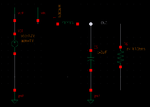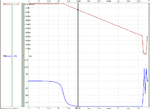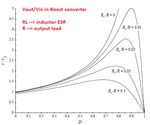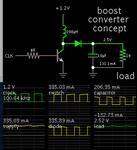reann
Newbie level 4
Good day everyone!Just would like to ask some few questions.
I am currently working on a design of boost converter with the following specifications:
Input voltage =1.2V
Output voltage=2.5V
Iload=130mA (R=19.3 ohms)
switching frequency=500KHz
in a TSMC65nm technology environment.
As per calculation, I derived with the following values of inductor and capacitor with the goal to operate in CCM:
L=657uH but Lfinal=900uH to make sure it operates in CCM mode
C=19nf but Cfinal=3uF to make ripple less approximately 1%
But have difficulty as I have tested/simulated the frequency of the RLC. As shown in the attachment below:


As shown above the RLC at crossover frequency (which I have chosen 1/6 of the switching frequency which is 83.3kHz). The gain needed to compensate is 58.5dB, which found to very large. To compensate. Is this value of mine realistic? If this is, can anyone suggest me what type of compensation should I used?Thank you
Btw, for now I have an operational amplifier with a gain of 70dB, phase >50 deg and UGB =10MHz.
I am currently working on a design of boost converter with the following specifications:
Input voltage =1.2V
Output voltage=2.5V
Iload=130mA (R=19.3 ohms)
switching frequency=500KHz
in a TSMC65nm technology environment.
As per calculation, I derived with the following values of inductor and capacitor with the goal to operate in CCM:
L=657uH but Lfinal=900uH to make sure it operates in CCM mode
C=19nf but Cfinal=3uF to make ripple less approximately 1%
But have difficulty as I have tested/simulated the frequency of the RLC. As shown in the attachment below:


As shown above the RLC at crossover frequency (which I have chosen 1/6 of the switching frequency which is 83.3kHz). The gain needed to compensate is 58.5dB, which found to very large. To compensate. Is this value of mine realistic? If this is, can anyone suggest me what type of compensation should I used?Thank you
Btw, for now I have an operational amplifier with a gain of 70dB, phase >50 deg and UGB =10MHz.



